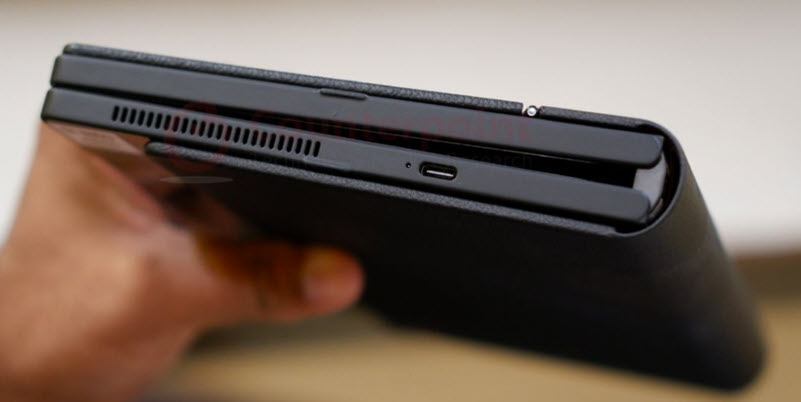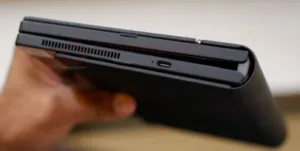On April 1, Li Ki-jong of the Korean technical news source The Elec reported that LG Display plans to begin volume manufacturing of 17″ foldable notebook OLED panels in the third quarter. The inward-folding 4K panel measures 11 inches when folded. Sources reported HP would be the first customer for these panels, with notebooks using the panel available in Q4’21 or Q1’22. The sources estimate that LGD will supply HP with up to 10,000 of the panels this year.

At the time of CES 2022 in January LGD announced such a panel, although the company decided not to have its usual VIP suite. Samsung Display showed several small to mid-sized folding displays at its VIP demonstration area. Included were two- and three-panel displays that folded either inward or outward; in one case the display folded both inward and outward, which would allow a tryptych-like display to fold accordion style.
Samsung Display is now advertising its “Eco²OLED™” foldable OLED which integrates the polarizer function into the display structure, replacing it with a filter and thus removing a separate film layer and increasing transmissivity by 33%. The new structure allows the color gamut to be increased to 90% of Rec. 2020, the company says. (see New Insights on How SDC Will Introduce Polarizer-Free OLEDs – subscription required).
We have reported previously on Lenovo’s “Thinkpad X1 Fold,” the world’s first folding-display laptop, which incorporated an LGD foldable OLED measuring 13.3 inches unfolded and 6.2 inches folded, and has 2048 x 1536 pixels. (MicroLED, QLED, OLED and MiniLED Displays Dazzle at CES 2020)
 The Lenovo X1 Fold computer with foldable LGD 13.3-inch OLED display. (Photo: Lenovo)
The Lenovo X1 Fold computer with foldable LGD 13.3-inch OLED display. (Photo: Lenovo)
More Foldables to be Introduced
It’s clear consumers will be subjected to more foldable display products than can be supported by legitimate use cases. The Lenovo X1 Fold, though impressive in many ways, is a case in point (Fig. 1). Specifically, where’s the keyboard? If you use half the display as a soft keyboard you have a classic notebook configuration, but with an inferior keyboard. Lenovo understood this and made an available Bluetooth keyboard that slips inside the computer for transport and is held in place by magnets. But if you want to work on a fold-out airplane table you’re back to using the soft keyboard. Perhaps you’d be happier with a conventional slim 13.3-inch laptop? Most people are. The X1 Fold sells only about 10,000 units per year, although the high price certainly contributes.
The use case looks better if you’re primarily an “information consumer” rather than an “information creator.” Then you can enjoy the nice OLED display that folds into a compact package, without lugging around the accessory keyboard.
I’m not bad-mouthing the X1 Fold, which is an impressive computer. I am saying that if foldables are going to outgrow the neat-expensive-toy niche, product managers will have think hard about where these beautiful and increasingly durable displays really do the job better than their non-folding cousins.
In other words, ya gotta know when to fold ’em. (KW)
Ken Werner is Philosopher Emeritus at Nutmeg Consultants and the 2017 recipient of the Society for Information Display’s Lewis and Beatrice Winner Award. You can reach him at [email protected].

